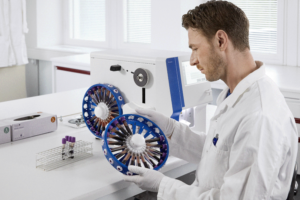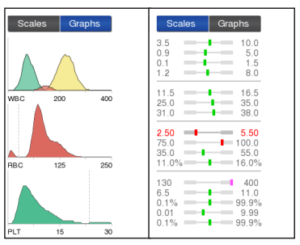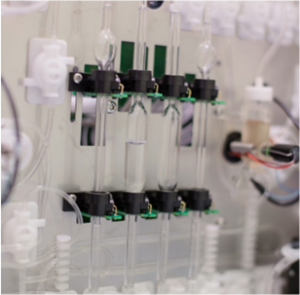Disadvantages of automated cell counters (and how they are overcome)
Automated cell counters have many advantages. These analyzers can count thousands of cells in a sample with high precision in less than a minute. In addition to the actual count, automated analyzers also report parameters related to cell size and a range of calculated parameter. Although their many advantages, automated cell counters also come with some disadvantages. This article focuses on their drawbacks to highlight the design features of Boule hematology analyzers to overcome these shortcomings, ultimately to provide you with a cost-efficient and easy to use tool that is available to support you in clinical decision-making.
Complete blood cell counts
The very first blood cell counters, introduced to the market as early as in the 50s, revolutionized hematology analysis (1). Today, a complete blood count (CBC) is one of the most requested laboratory tests by physicians (2). CBC testing is conducted daily in virtually every clinical laboratory worldwide for screening of medical conditions and to follow up on disease progression and treatment (3).
Overcoming challenges with automated cell counting
Automated hematology analyzers can be costly to purchase, use, and maintain. With this in mind, Boule Diagnostics has had its focus on the small to mid-sized laboratories, with products tailored to cost-efficient hematology analysis in decentralized clinical settings.
Cost
Analyzers intended for large hospital laboratories are often complex, use a number of reagents, and might require hours for daily maintenance. Miniaturized technologies initially intended for larger laboratories in order to provide solutions also for smaller laboratories can come with unnecessary complexity and costs.
With a compact design and using only two reagents, Boule hematology analyzers are purpose-built for the smaller laboratory. On-site CBC testing using a small, benchtop analyzer can provide results within a minute compared with sending samples away for analysis. A CBC is also a cost-efficient analysis compared with more specific test such as PCR or immunoassays, and blood cultures can take days to results. The CBC results can help suggest a likely diagnosis, while waiting for confirmatory tests.

On-site CBC testing using a small, benchtop analyzer
Training
Blood cell counters are analytically and technically complex automated systems, reporting a range of parameters in both a list of values as well as visualized in histograms and scatterplots. Users might also struggle with performing routine maintenance and troubleshooting of technical issues.
Boule hematology analyzers are intended to be used in decentralized clinical settings, where service and support might be at a far distance. As such, these analyzers are designed to be easy to use and understand.
To further simplify, Boule hematology analyzers equipped with the micro-pipette adapter (MPA) function allows for a complete blood count from a fingerstick sample of blood collected in a capillary tube. No excess blood collection, no vacuum tubes, or mixing required.

Micro-pipette adapter (MPA) provides a blood status from a finger-stick capillary sample.
Automation
Most modern hematology analyzers do not require manual sample handling or preparation prior to analysis. Many analyzers are also equipped with automated sample loading. Although large hospital laboratories often benefit from total laboratory automation (TLA), connecting all aspects of the laboratory process, comprising the pre-analytic, analytic, and post analytic phases, many smaller laboratories are not set up in this way.
For a CBC, the blood is typically collected in an EDTA tube and gently mixed prior to analysis to prevent clotting. However, too vigorous or delayed or omitted mixing can affect the results. When working under stress, it can be easy for healthcare workers to forget the mixing step. Boule hematology analyzers variants equipped with an automated sample loader that is also a mixer takes care of pre-analytical mixing of samples before analysis.

Medonic M32 equipped with an automated sample loader
Inaccuracy
Many abnormal or variant cells can be hard for an automated hematology analyzer to distinguish from the corresponding normal cells of the same size. However, the proportion of abnormal samples that require a manual examination under the microscope is in many clinical settings 10 to 15 percent or less (4), meaning the larger part of all samples are normal and will not require a blood smear analysis. In case of abnormalities, Boule hematology analyzers will give a pathology flag to alert the operator. The information can be triggered by the following mechanisms:
- Histogram shape abnormalities detected by system software calculations.
- Selected values that exceed defined limits outside the reference range.
These messages occur when selected values are moderately to markedly abnormal.
In summary, you let the analyzer do the actual count, while blood smear analysis is used to follow-up sample results that are flagged as abnormal by the analyzer.

Sample result from hematology analyzer
Maintenance
Maintenance of an automated cell counter might mean hours of downtime when the analyzer is not available for reporting results for use in clinical decision-making.
With a closed fluidic system and automated cleaning procedures, the Boule hematology analyzers are designed for a reliable performance to minimize maintenance and service needs, maximizing uptime and analyzer availability to provide patient results.

Boule hematology analyzer have a closed fluidic system and automated cleaning procedures
Calibration
Regular calibration is required for many analyzers to maintain their performance.
Boule hematology analyzers uses a rotary shear valve for sample aspiration. The aspiration is stopped by a blood sensor and a precise volume is cut and brought to a closed mixing chamber using diluent reagent. This way, no mechanical movement of the aspiration module is required, minimizing the maintenance needs. As the shear valve cuts the same precise volume for each measurement, the analyzer calibration stays stable for a longer period of time.
For the cell count, the diluted sample pushes the liquid (diluent) in a metering unit, consisting of a glass tube and two optical sensors. When the diluent flows through the tube, it first triggers the start-sensor and then the stop-sensor and the cell count is registered during these two trigger events. The volume between the start- and stop-sensors is equal to the measured volume of the diluted sample used for the cell count.
The interval of reaching from the start-sensor to the stop-sensor might vary due to a partial clog of the aperture over time, however, the cell count will continue until the diluent reaches the stop-sensor and a constant volume is thus always recorded, ensuring precise and accurate results.
To reduce operator maintenance, Boule hematology analyzers feature a closed shear valve design to prevent that salt crystals and blood remnants that get in contact with air deposit at the junction of the two discs. To reduce risk for clogging, aperture cleaning is automatically carried out by the analyzer.

The shear valve cuts the same precise volume for each measurement
Read more
Visit Boule Academy to learn more about Boule hematology analyzers and their applications.
References
- Öhlin, E. Automatisk cellräknings-metod – speciellt för blodkroppar. Nordisk Medicin 59, 577–578(1958).
- Daves et al. Modern hematology analyzers: beyond the simple blood cells count (with focus on the red blood cells). J Lab Precis Med 9, doi: 10.21037/jlpm-23-32 (2024).
- Vis and Huisman. Verification and quality control of routine hematology analyzers. Int J Lab Hematol 38 (Suppl. 1), 100–109 (2016).
- Bain, B.J. Diagnosis from the Blood Smear. N Engl J Med 353, 498-507 (2005).
